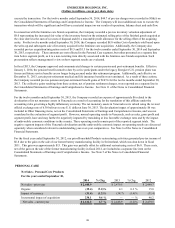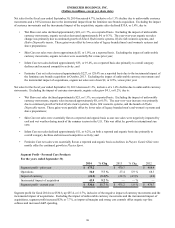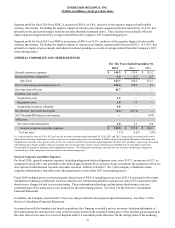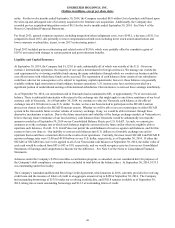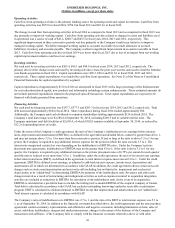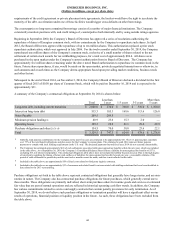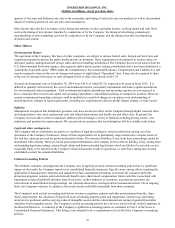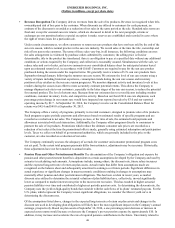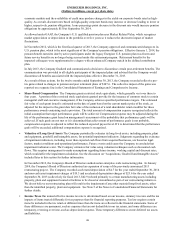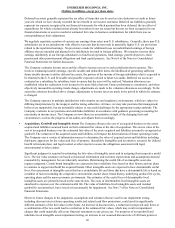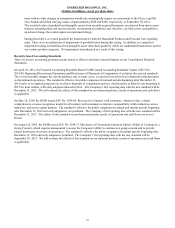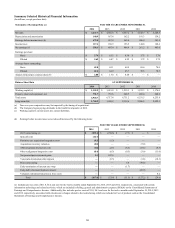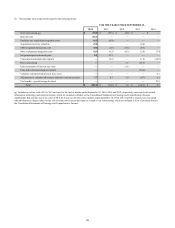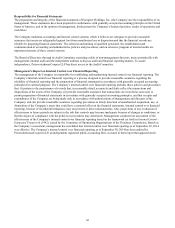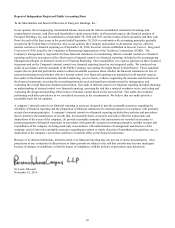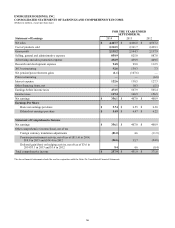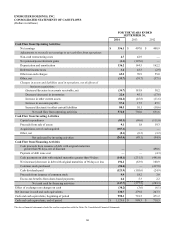Energizer 2014 Annual Report Download - page 52
Download and view the complete annual report
Please find page 52 of the 2014 Energizer annual report below. You can navigate through the pages in the report by either clicking on the pages listed below, or by using the keyword search tool below to find specific information within the annual report.
ENERGIZER HOLDINGS, INC.
(Dollars in millions, except per share data)
• Revenue Recognition The Company derives revenues from the sale of its products. Revenue is recognized when title,
ownership and risk of loss pass to the customer. When discounts are offered to customers for early payment, an
estimate of the discounts is recorded as a reduction of net sales in the same period as the sale. Standard sales terms are
final and, except for seasonal sun care returns, which are discussed in detail in the next paragraph, returns or
exchanges are not permitted unless a special exception is made; reserves are established and recorded in cases where
the right of return exists for a particular sale.
Under certain circumstances, we allow customers to return sun care products that have not been sold by the end of the
sun care season, which is normal practice in the sun care industry. We record sales at the time the title, ownership and
risk of loss pass to the customer. The terms of these sales vary but, in all instances, the following conditions are met:
the sales arrangement is evidenced by purchase orders submitted by customers; the selling price is fixed or
determinable; title to the product has transferred; there is an obligation to pay at a specified date without any additional
conditions or actions required by the Company; and collection is reasonably assured. Simultaneous with the sale, we
reduce sales and cost of sales, and reserve amounts on our consolidated balance sheet for anticipated returns based
upon an estimated return level, in accordance with GAAP. Customers are required to pay for the sun care product
purchased during the season under the required terms. We generally receive returns of U.S. sun care products from
September through January following the summer sun care season. We estimate the level of sun care returns using a
variety of inputs including historical experience, consumption trends during the sun care season and inventory
positions at key retailers as the sun care season progresses. We monitor shipment activity and inventory levels at key
retailers during the season in an effort to more accurately estimate potential returns. This allows the Company to
manage shipment activity to our customers, especially in the latter stages of the sun care season, to reduce the potential
for returned product. The level of returns may fluctuate from our estimates due to several factors including weather
conditions, customer inventory levels, and competitive activity. Based on our fiscal 2014 sun care shipments, each
percentage point change in our returns rate would have impacted our reported net sales by $3.0 and our reported
operating income by $2.7. At September 30, 2014, the Company's reserve on the Consolidated Balance Sheet for
returns was $45.4 and $49.8 at September 30, 2013.
The Company offers a variety of programs, primarily to its retail customers, designed to promote sales of its products.
Such programs require periodic payments and allowances based on estimated results of specific programs and are
recorded as a reduction to net sales. The Company accrues, at the time of sale, the estimated total payments and
allowances associated with each transaction. Additionally, the Company offers programs directly to consumers to
promote the sale of its products. Promotions which reduce the ultimate consumer sale prices are recorded as a
reduction of net sales at the time the promotional offer is made, generally using estimated redemption and participation
levels. Taxes we collect on behalf of governmental authorities, which are generally included in the price to the
customer, are also recorded as a reduction of net sales.
The Company continually assesses the adequacy of accruals for customer and consumer promotional program costs
not yet paid. To the extent total program payments differ from estimates, adjustments may be necessary. Historically,
these adjustments have not been material to annual results.
• Pension Plans and Other Postretirement Benefits The determination of the Company’s obligation and expense for
pension and other postretirement benefits is dependent on certain assumptions developed by the Company and used by
actuaries in calculating such amounts. Assumptions include, among others, the discount rate, future salary increases
and the expected long-term rate of return on plan assets. Actual results that differ from assumptions made are
recognized on the balance sheet and subsequently amortized to earnings over future periods. Significant differences in
actual experience or significant changes in macroeconomic conditions resulting in changes to assumptions may
materially affect pension and other postretirement obligations. This has been evident in recent years, as market
discount rates utilized to determine the actuarial valuation of plan liabilities have, collectively, moved significantly
lower as compared to market interest rates prior to the most recent recession. This has resulted in higher actuarial
pension liabilities over time and contributed to higher net periodic pension costs. In determining the discount rate, the
Company uses the yield on high-quality bonds that coincide with the cash flows of its plans’ estimated payouts. For the
U.S. plans, which represent the Company’s most significant obligations, we consider the Mercer yield curve in
determining the discount rates.
Of the assumptions listed above, changes in the expected long-term rate of return on plan assets and changes in the
discount rate used in developing plan obligations will likely have the most significant impact on the Company’s annual
earnings, prospectively. Based on plan assets at September 30, 2014, a one percentage point decrease or increase in
expected asset returns would increase or decrease the Company’s pre-tax pension expense by approximately $10. In
addition, it may increase and accelerate the rate of required pension contributions in the future. Uncertainty related to
48


